223 scholarly books by University of London Press and 15
have author last names that start with F
223 scholarly books by University of London Press and 15
223 scholarly books by University of London Press
15 have author last names that start with F have author last names that start with F
15 have author last names that start with F have author last names that start with F

'She said she was in the family way'
Pregnancy and Infancy in Modern Ireland
Elaine Farrell
University of London Press, 2012
She said she was in the family way' examines the subject of pregnancy and infancy in Ireland from the seventeenth to the twentieth century. It draws on exciting and innovative research by early-career and established academics, and consider topics that have been largely ignored by historians in Ireland. The book will make an important contribution to Irish women’s history, family history, childhood history, social history, crime history and medical history, and will provide a reference point for academics interested in themes of sexuality, childbirth, infanthood and parenthood.
[more]

Chile and the Inter-American Human Rights System
Karinna Fernández
University of London Press, 2017
This book reflects on the relationship between Chile and the Inter-American Human Rights System, focusing on an interdisciplinary and detailed examination of the consequences of recent cases decided by the Inter-American Court of Human Rights against the Chilean state. These cases illustrate central challenges in the areas of Lesbian, Gay, Bisexual, Transgender and Intersex rights, as well as shedding light on torture and indigenous rights in Chile and the Americas as a whole.
[more]

A return to the village
community ethnographies and the study of Andean culture in retrospective
Francisco Ferreira
University of London Press, 2016
This edited volume brings together several scholars who have produced outstanding ethnographies of Andean communities, mostly in Peru but also in neighbouring countries. These ethnographies were published between the 1970s and 2000s, following different theoretical and thematic approaches, and they often transcended the boundaries of case studies to become important reference works on key aspects of Andean culture: for example, the symbolism and ritual uses of coca in the case of Catherine J. Allen; agricultural rituals and internal social divisions in the case of Peter Gose; social organisation and kinship in the case of Billie Jean Isbell; the use of khipus and concepts of literacy in the case of Frank Salomon; and the management and ritual dimensions of water and irrigation in the case of Ricardo Valderrama and Carmen Escalante. In their chapters the authors revisit their original works in the light of contemporary anthropology, focusing on different academic and personal aspects of their ethnographies. For example, they explain how they chose the communities they worked in; the personal relations they established there during fieldwork; the kind of links they have maintained; and how these communities have changed over time. They also review their original methodological and theoretical approaches and findings, reassessing their validity and explaining how their views have evolved or changed since they originally conducted their fieldwork and published their studies. This book also offers a review of the evolution and role of community ethnographies in the context of Andean anthropology. These ethnographies had a significant influence between the 1940s and 1980s, when they could be roughly divided – following Olivia Harris – between ‘long-termist’ and ‘short-termist’ approaches, depending on predominant focuses on historical continuities or social change respectively. However, by the 1990s these works came to be widely considered as too limited and subjective in the context of wider academic changes, such as the emergence of postmodern trends, and reflective and literary turns in anthropology. Overall, the book aims to reflect on this evolution of community ethnographies in the Andes, and on their contribution to the study of Andean culture.
[more]

Borges and Europe Revisited
Evelyn Fishburn
University of London Press, 1998

Science and the Creative Imagination in Latin America
Evelyn Fishburn
University of London Press, 2004

The Victoria History of Leicestershire
Buckminster and Sewstern
Pamela J. Fisher
University of London Press, 2017
Buckminster and Sewstern, in north-east Leicestershire, are two small villages within a single parish, and although both were established before 1086, they have developed different characters. Buckminster was purely an agricultural village until the 1790s, when Sir William Manners enlarged a small park, built a mansion and began to create an estate village. Many of the houses are of red brick, and were built for estate employees by the 9th earl of Dysart between 1878 and 1935, as part of a programme of village improvements. All the land, residential and commercial properties in Buckminster were held in 2017 by the Tollemache family, descendants of Sir William and Lord Dysart. In contrast, Sewstern’s houses are individual in character, and mostly built from local limestone. Before the 20th century, many had large paddocks to the rear. The village is near the presumed ancient route known as Sewstern Lane, and a wide range of trades were followed between the 14th and 19th centuries, until the age of the railways ended the passing trade. Land in both villages was quarried for ironstone in the 20th century, then reinstated for farmland, resulting in fields that are several feet below the level of the roads and property curtilages. This book explores the similarities and differences between the two villages over more than a thousand years of recorded history.
[more]
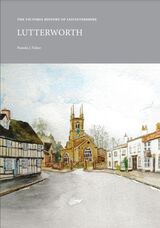
The Victoria History of Leicestershire
Lutterworth
Pamela J. Fisher
University of London Press, 2022
This volume in the Victoria County History series centers on the town of Lutterworth.
From before the Norman Conquest to the development of the jet engine, this volume tells the history of Lutterworth, a small market town in the southwest of Leicestershire. A combination of factors ensured the town’s success, including its position linking the rich agricultural land of south Leicestershire with the Warwickshire Arden and its natural resources of wood and coal. Lutterworth also played a role on the national stage, first in 1428, when the bones of the town rector, the theologian John Wyclif, were disinterred and desecrated on the instructions of the Pope. Lutterworth also made headlines between 1937 and 1942, when Frank Whittle developed the jet engine in a disused foundry in the town.
This book focuses on the people of Lutterworth and the roles they played in shaping the economy, schools, hospitals, churches, and the social life of the community. The evolution and development of the town are described in these pages, from its humble beginnings to the challenges it faces today.
From before the Norman Conquest to the development of the jet engine, this volume tells the history of Lutterworth, a small market town in the southwest of Leicestershire. A combination of factors ensured the town’s success, including its position linking the rich agricultural land of south Leicestershire with the Warwickshire Arden and its natural resources of wood and coal. Lutterworth also played a role on the national stage, first in 1428, when the bones of the town rector, the theologian John Wyclif, were disinterred and desecrated on the instructions of the Pope. Lutterworth also made headlines between 1937 and 1942, when Frank Whittle developed the jet engine in a disused foundry in the town.
This book focuses on the people of Lutterworth and the roles they played in shaping the economy, schools, hospitals, churches, and the social life of the community. The evolution and development of the town are described in these pages, from its humble beginnings to the challenges it faces today.
[more]

The Victoria History of Leicestershire
Castle Donington
Pamela J. Fisher
University of London Press, 2016
The parish of Castle Donington in north-west Leicestershire lies on the south bank of the river Trent, 20 miles north-west of Leicester and 8 miles south-east of Derby. A nucleated village developed on the present site more than 1,000 years ago. A castle was built in the 1150s, and several features of a town soon developed, including a market, fair and hospital. Secondary settlements grew up alongside the Trent, by the King’s Mills and at Cavendish Bridge, the site of an important medieval ferry. Donington Park, which originated in the early 13th century as a hunting park, became a separate estate of the earls of Huntingdon in the late 16th century. Later history has been shaped by strong religious nonconformity and the growth and then decline of traditional industries in the 18th and 19th centuries. Since then, modern transport links, including East Midlands Airport in the south of the parish, have delivered new employment opportunities. Castle Donington in the early 21st century is thriving. Many people travel in daily to work, and thousands more visit the motor-racing circuit at Donington Park and other leisure attractions each year, yet few know of the parish’s rich history. This book, the first in the Leicestershire VCH series since 1964, examines the changing patterns of landscape, landownership, working lives, social structure and religious worship in Castle Donington across many centuries, and includes the settlements at King’s Mills and Cavendish Bridge. It will be of interest to local residents, visitors, family and local historians.
[more]
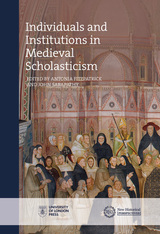
Individuals and Institutions in Medieval Scholasticism
Antonia Fitzpatrick
University of London Press, 2020
Individuals and Institutions in Medieval Scholasticism is one of the first pieces of close exploratory scholarship on the fundamental relationship between medieval scholastic thought, individual scholars, and their institutions. The text revolves around these essential questions: What was the relationship between particular intellectuals and their wider networks (including but not limited to “schools”), how did intellectuals shape their institutions, and how were their institutions shaped by them? This theoretically sophisticated collection uses a range of European methodological approaches to address a variety of genres such as commentaries, quodlibetal questions, polemics, epic poetry, and inquisition records, and a range of subject matter including history, practical ethics, medicine, theology, philosophy, the constitution of religious orders, the practice of confession, and the institution of cults. This book will be an important reference point for medieval historians, while also raising questions relevant to those working on individualization and institutionalization in other periods and disciplines.
[more]

Glanz und Abglanz
Two Centuries of German Studies in the University of London
John L. Flood
University of London Press, 2017
In 1943, in the midst of a London still reeling from the Blitz, initial plans were laid for an Institute devoted to rebuilding relations between English and German scholars and academics once hostilities had ceased. Established in 1950, the Institute served for more than half a century as a research centre and focal point for researchers the world over. However, German Studies in London have a much older tradition which goes back almost two centuries. Glanz und Abglanz tells the fascinating tale of German Studies in London from its beginnings at the ‘godless institution of Gower Street’, and the remarkable personalities whose energy and commitment ensured that the discipline flourished. The story is told through two essays: ‘Taught by Giants’ outlining the history of the subject in London from 1826, and ‘“Sehr schön, Piglet?” “Ja, Pooh.”’ following the development of the Institute of Germanic Languages and Literatures and showcasing its remarkable library. The volume is rounded off with an account of the magnificent collection of rare books assembled by two of the personalities, Robert Priebsch (1866–1935) and August Closs (1898–1990). John L. Flood has been associated with the University of London for more than fifty years, having taught German at King’s College from 1965 until 1979, when he was appointed Deputy Director of the Institute of Germanic Studies. Since his retirement in 2002, Professor Flood has been an Honorary Fellow of the Institute. Anne Simon took her PhD at the University of London, then became Lecturer in Medieval German at the University of Bristol from 1992 to 2011. She held a temporary Lectureship at the Institute of Germanic & Romance Studies, London, in 2012–13, and is now an Associate Fellow of the Institute of Modern Languages Research.
[more]

Word on the Street
Elisha Foust
University of London Press, 2011
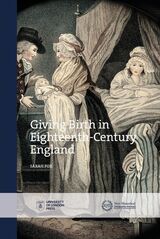
Giving Birth in Eighteenth-Century England
Sarah Fox
University of London Press, 2022
A history of childbirth in the eighteenth century as told by women.
This fascinating new book radically rewrites all that we know about eighteenth-century childbirth by placing women’s voices at the center of the story. Examining childbirth from the perspective of the birthing woman, this research offers new perspectives on the history of the family, the social history of medicine, community and neighborhood studies, and the study of women’s lives in eighteenth-century England.
From “quickening” through to “confinement,” “giving caudle,” delivery, and “lying-in,” birth was once a complex ritual that involved entire communities. Drawing on an extensive and under-researched body of materials, such as letters, diaries, and recipe books, this book offers critical new perspectives on the history of the family, community, and the lives of women in the coming age of modern medicine. It unpacks the rituals of contemporary childbirth—from foods traditionally eaten before and after birth, birthing clothing, and how a woman’s relationship with her family, husband, friends, and neighbors changed during and after pregnancy. In this important and deeply moving study, we are invited onto a detailed and emotional journey through motherhood in an age of immense socio-cultural and intellectual change.
This fascinating new book radically rewrites all that we know about eighteenth-century childbirth by placing women’s voices at the center of the story. Examining childbirth from the perspective of the birthing woman, this research offers new perspectives on the history of the family, the social history of medicine, community and neighborhood studies, and the study of women’s lives in eighteenth-century England.
From “quickening” through to “confinement,” “giving caudle,” delivery, and “lying-in,” birth was once a complex ritual that involved entire communities. Drawing on an extensive and under-researched body of materials, such as letters, diaries, and recipe books, this book offers critical new perspectives on the history of the family, community, and the lives of women in the coming age of modern medicine. It unpacks the rituals of contemporary childbirth—from foods traditionally eaten before and after birth, birthing clothing, and how a woman’s relationship with her family, husband, friends, and neighbors changed during and after pregnancy. In this important and deeply moving study, we are invited onto a detailed and emotional journey through motherhood in an age of immense socio-cultural and intellectual change.
[more]
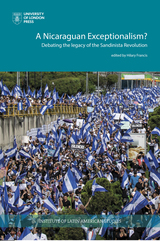
Nicaraguan Exceptionalism? Debating the Legacy of the Sandinista Revolution
Hilary Francis
University of London Press, 2019
In recent years, child migrants from Central America have arrived in the United States in unprecedented numbers. But whilst minors from Honduras, Guatemala and El Salvador make the perilous journey to the north, their Nicaraguan peers have remained in Central America. Nicaragua also enjoys lower murder rates and far fewer gang problems when compared with her neighbours. Why is Nicaragua so different? The present government has promulgated a discourse of Nicaraguan exceptionalism, arguing that Nicaragua is unique thanks to heritage of the 1979 Sandinista revolution. This volume critically interrogates that claim, asking whether the legacy of the revolution is truly exceptional. An interdisciplinary work, the book brings together historians, anthropologists and sociologists to explore the multifarious ways in which the revolutionary past continues to shape public policy - and daily life - in Nicaragua’s tumultuous present.
[more]
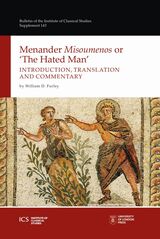
Menander "Misoumenos" or "The Hated Man"
Introduction, Translation, and Commentary
William Furley
University of London Press, 2021
Based on recently discovered fragments, this is one of the most complete English-language publications of Misoumenos, or The Hated Man.
Menander’s Misoumenos, or The Hated Man, is one of his most popular plays to have survived from classical times. Dating to approximately 300 BCE, it tells the story of a mercenary soldier and the captive girl he acquires while on campaign in Cyprus. The play follows the soldier’s growing despair as the girl spurns his advances and slowly turns against him, culminating in his suicidal thoughts.
The play belongs to the ancient genre of New Comedy, of which Menander was the acknowledged master. This edition presents a significantly updated text and the fullest English language translation of the play to date. It aims to restore as much as possible of the action of Misoumenos, reconstructing the language, stagecraft, and theatrical dialogue of the original based on hypothesis and reconstruction. Some sections can be restored nearly in full, permitting access to brilliantly original theatrical dialogue which had been lost for over two millennia. Apart from meter and sophisticated idiom, the themes of love, despair, and sadness that Menander treats are utterly timeless.
Menander’s Misoumenos, or The Hated Man, is one of his most popular plays to have survived from classical times. Dating to approximately 300 BCE, it tells the story of a mercenary soldier and the captive girl he acquires while on campaign in Cyprus. The play follows the soldier’s growing despair as the girl spurns his advances and slowly turns against him, culminating in his suicidal thoughts.
The play belongs to the ancient genre of New Comedy, of which Menander was the acknowledged master. This edition presents a significantly updated text and the fullest English language translation of the play to date. It aims to restore as much as possible of the action of Misoumenos, reconstructing the language, stagecraft, and theatrical dialogue of the original based on hypothesis and reconstruction. Some sections can be restored nearly in full, permitting access to brilliantly original theatrical dialogue which had been lost for over two millennia. Apart from meter and sophisticated idiom, the themes of love, despair, and sadness that Menander treats are utterly timeless.
[more]

Menander 'Perikeiromene' or 'The Shorn Head'
William D. Furley
University of London Press, 2015
Menander set Perikeiromene, or the ‘Woman with shorn head’ in Corinth, famous for its beautiful women, at a time when the city's troubles were at their height owing to the Macedonian conquest of Greece. The story reflects in miniature some of the turbulence of the times. A mercenary soldier Polemon returns home from service to discover, as he thinks, that his girl, Glykera, has found another lover. In a fit of jealous rage he shears off her hair and goes off to drown his sorrows with companions. Glykera promptly moves out from Polemon's house to the neighbour's house, in which her purported new lover Moschion lives. But all is not as it seems... Typically for the genre of New Comedy, Menander takes his characters to the brink in this lively drama before the recognitions which set everything straight. Discoveries of fragmented manuscripts of this play in the twentieth century have more or less brought it back to life.
[more]
READERS
Browse our collection.
PUBLISHERS
See BiblioVault's publisher services.
STUDENT SERVICES
Files for college accessibility offices.
UChicago Accessibility Resources
home | accessibility | search | about | contact us
BiblioVault ® 2001 - 2024
The University of Chicago Press









